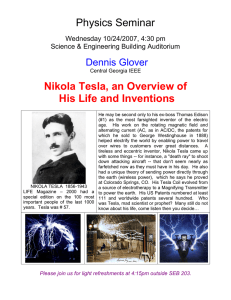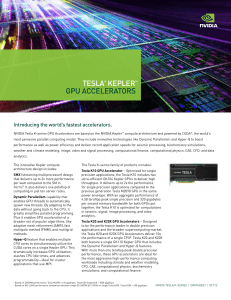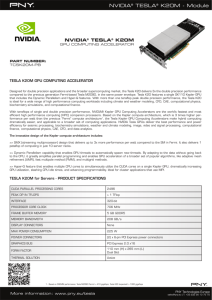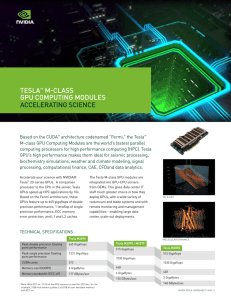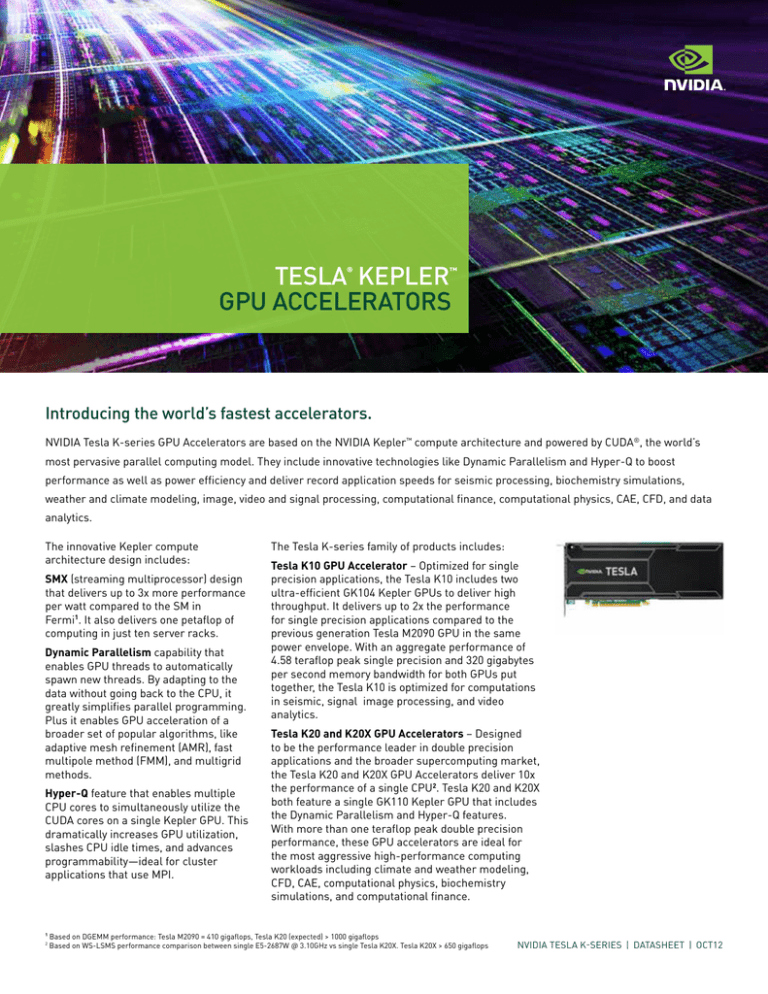
Tesla Kepler
GPU Accelerators
®
™
Introducing the world’s fastest accelerators.
NVIDIA Tesla K-series GPU Accelerators are based on the NVIDIA Kepler™ compute architecture and powered by CUDA®, the world’s
most pervasive parallel computing model. They include innovative technologies like Dynamic Parallelism and Hyper-Q to boost
performance as well as power efficiency and deliver record application speeds for seismic processing, biochemistry simulations,
weather and climate modeling, image, video and signal processing, computational finance, computational physics, CAE, CFD, and data
analytics.
The innovative Kepler compute
architecture design includes:
SMX (streaming multiprocessor) design
that delivers up to 3x more performance
per watt compared to the SM in
Fermi1. It also delivers one petaflop of
computing in just ten server racks.
Dynamic Parallelism capability that
enables GPU threads to automatically
spawn new threads. By adapting to the
data without going back to the CPU, it
greatly simplifies parallel programming.
Plus it enables GPU acceleration of a
broader set of popular algorithms, like
adaptive mesh refinement (AMR), fast
multipole method (FMM), and multigrid
methods.
Hyper-Q feature that enables multiple
CPU cores to simultaneously utilize the
CUDA cores on a single Kepler GPU. This
dramatically increases GPU utilization,
slashes CPU idle times, and advances
programmability—ideal for cluster
applications that use MPI.
1
2
The Tesla K-series family of products includes:
Tesla K10 GPU Accelerator – Optimized for single
precision applications, the Tesla K10 includes two
ultra-efficient GK104 Kepler GPUs to deliver high
throughput. It delivers up to 2x the performance
for single precision applications compared to the
previous generation Tesla M2090 GPU in the same
power envelope. With an aggregate performance of
4.58 teraflop peak single precision and 320 gigabytes
per second memory bandwidth for both GPUs put
together, the Tesla K10 is optimized for computations
in seismic, signal image processing, and video
analytics.
Tesla K20 and K20X GPU Accelerators – Designed
to be the performance leader in double precision
applications and the broader supercomputing market,
the Tesla K20 and K20X GPU Accelerators deliver 10x
the performance of a single CPU2. Tesla K20 and K20X
both feature a single GK110 Kepler GPU that includes
the Dynamic Parallelism and Hyper-Q features.
With more than one teraflop peak double precision
performance, these GPU accelerators are ideal for
the most aggressive high-performance computing
workloads including climate and weather modeling,
CFD, CAE, computational physics, biochemistry
simulations, and computational finance.
Based on DGEMM performance: Tesla M2090 = 410 gigaflops, Tesla K20 (expected) > 1000 gigaflops
Based on WS-LSMS performance comparison between single E5-2687W @ 3.10GHz vs single Tesla K20X. Tesla K20X > 650 gigaflops
NVIDIA Tesla K-Series | Datasheet | Oct12
Technical Specifications
a
b
Tesla K10a
Tesla K20
Tesla K20X
Peak double precision floating point
performance (board)
0.19 teraflops
1.17 teraflops
1.31 teraflops
Peak single precision floating point
performance (board)
4.58 teraflops
3.52 teraflops
3.95 teraflops
Number of GPUs
2 x GK104s
1 x GK110
Number of CUDA cores
2 x 1536
2496
2688
Memory size per board (GDDR5)
8 GB
5 GB
6 GB
Memory bandwidth for board (ECC off)b
320 GBytes/sec
208 GBytes/sec
250 GBytes/sec
GPU computing applications
Seismic, image, signal
processing, video analytics
CFD, CAE, financial computing, computational chemistry
and physics, data analytics, satellite imaging, weather
modeling
Architecture features
SMX
SMX, Dynamic Parallelism, Hyper-Q
System
Servers only
Servers and Workstations
Servers only
Tesla K10 specifications are shown as aggregate of two GPUs.
With ECC on, 12.5% of the GPU memory is used for ECC bits. So, for example, 6 GB total memory yields 5.25 GB of user available memory with ECC on.
Features and Benefits
ECC memory error protection
Meets a critical requirement for computing accuracy and reliability in data centers and
supercomputing centers. External DRAM is ECC protected in Tesla K10. Both external and internal
memories are ECC protected in Tesla K20 and K20X.
System monitory features
Integrates the GPU subsystem with the host system’s monitoring and management capabilities
such as IPMI or OEM-proprietary tools. IT staff can now manage the GPU processors in the
computing system using widely used cluster/grid management solutions.
L1 and L2 caches
Accelerates algorithms such as physics solvers, ray-tracing, and sparse matrix multiplication
where data addresses are not known beforehand.
Asynchronous transfer with
dual DMA engines
Turbocharges system performance by transferring data over the PCIe bus while the computing
cores are crunching other data.
Flexible programming
environment with broad
support of programming
languages and APIs
Choose OpenACC, CUDA toolkits for C, C++, or Fortran to express application parallelism and take
advantage of the innovative Kepler architecture.
Software and Drivers
>>Software applications page:
www.NVIDIA.com/TeslaApps
>>Tesla GPU computing accelerators are
supported for both Linux and Windows.
Server modules are only supported on
64-bit OSes and workstation/desktop
modules are supported for 32-bit as well.
>>Drivers– NVIDIA recommends that
users get drivers for Tesla server
products from their system OEM to
ensure that the driver is qualified by
the OEM on their system. The latest
drivers can be downloaded from
www.NVIDIA.com/Drivers
To learn more about NVIDIA Tesla, go to www.NVIDIA.com/Tesla
© 2012 NVIDIA Corporation. All rights reserved. NVIDIA, the NVIDIA logo, Tesla, Kepler, and CUDA are trademarks and/or registered
trademarks of NVIDIA Corporation. All company and product names are trademarks or registered trademarks of the respective owners
with which they are associated. Features, pricing, availability, and specifications are all subject to change without notice. OCT12
>>Learn more about Tesla data center
management tools at www.NVIDIA.com/
object/softwarefor-tesla-products.html
>>Software development tools are available
at http://developer.nvidia.com/gettingstarted-parallelcomputing

